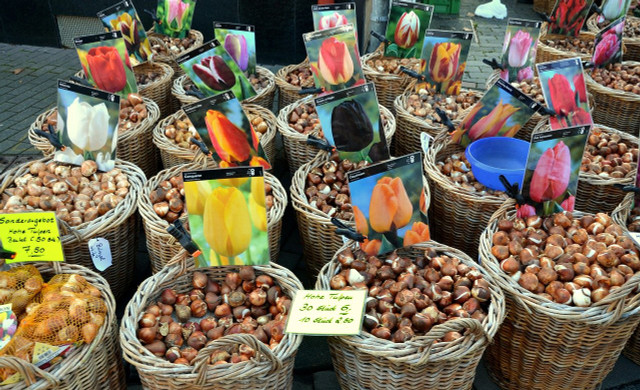If you prepare your garden for winter properly, you can enjoy a healthier, more beautiful garden with less work next year. Simply follow our quick five-step checklist.
As the autumn days draw in, it’s time to ready your garden for winter. Because of the cold and the shorter days, you should make sure that your plants survive this period unharmed and can blossom again in spring. Here are five tips to help prepare your garden for winter.
1. Raking Leaves and Fertilizing
Falling leaves are a clear sign that fall is here – it’s right there in the name! To save yourself work, wait until after the first frost to rake up the leaves in your garden for winter. By then, most of the leaves will have fallen. Rake your lawn thoroughly: This will ensure that you have removed any moss and fallen leaves, so that no bare patches form in the grass.
If you like, you can also make several piles of leaves in different places in your garden. They provide a protective winter home for hedgehogs, mice, and insects (or you can even build your own bug hotel using our guide right here!).

Before the onset of winter, you should mow your lawn to a length of about six centimeters. Afterwards, you can feed it with organic lawn fertilizer, or apply lime to the lawn (which you can buy, for example, on Amazon**). The micronutrients contained in the fertilizer help your lawn to survive the cold and to remain dense and robust.
2. Prune Bushes, Trees, and Perennials



Once they’ve lost all their leaves (or with evergreens, before the first hard frost), you should cut back trees, bushes, and perennial shrubs in your garden. This will allow them to gather enough strength over the winter to bud again next spring. To prepare your garden for winter properly, most species should be pruned before the first frost. This will allow the pruning cuts to close in time to not be damaged by the cold.
Cut off diseased and dead branches from trees and shrubs directly at the trunk. Don’t hesitate to trim shoots that have grown too long. You can cut down withered shrubs to a height of ten centimeters as soon as their leaves have turned brown. Take care not to cut off the freshly formed wintering buds of perennials. The first shoots develop from these the following spring.
Tip: Branches and twigs will usually only turn to compost pretty slowly. Instead of simply throwing them away, you can process them into nutrient-rich mulch. Cut or chop your clippings into small pieces and distribute them around frost-sensitive plants.
3. Prepare Your Garden for Winter by Protecting Plants from Frost
Frost-sensitive plants must be protected from the cold. So bring potted plants into the house before the first frost. However, don’t transfer them directly from the fresh air outdoors into the heated indoor air. Ideally, they should spend the winter in the basement or in an unheated room.
Plants that are frost-resistant to a certain degree can stay in the garden for winter, if they are protected properly. Wrap the pots and plants completely in a heat-storing and breathable fabric. Mats made of natural fibers such as jute, fleece, or coconut are all excellent, sustainable choices (e.g. on Amazon**). Remember to water your plants regularly despite the cold – but not in frosty weather.
4. Cover Flowerbeds and Plant Early Bloomers
The plants in your beds also need protection against the cold. You can simply spread your swept-up autumn leaves over them. Any mulch you may have made yourself from pruning cut-offs is also suitable for this purpose. Your bedding plants’ roots should be especially well-covered – this is where the garden plants store their energy for winter.



You can cover herbaceous plants such as lavender, rosemary, and sage with decorative evergreen branches. Before you cover your garden beds for winter, don’t forget to plant the bulbs for next year’s early bloomers. You should plant crocuses, daffodils, hyacinths, tulips, and snowdrops in fall.
For perennial flowers that are not hardy, such as dahlias or begonias, dig out the bulbs. To do this, first remove the withered leaves completely, then lift the bulb with its roots out of the ground, digging in a generous radius. Once you have freed the bulb from excess soil, you can store it in a cool, dry place for the winter.
5. Prepare Your Garden Tools for Winter



Now you’ve prepared your garden for winter, make sure that your garden tools will survive the winter unscathed too. Apply a little oil to electrical tools such as lawn mowers and hedge trimmers, and make sure everything’s free of soil and dirt. Remember to use biological cleaning agents such as lime. Stow your tools in a dry, frost-free spot until spring: This will prevent rust or mold from forming.
Delicate wooden garden furniture or garden decorations are also better off stored inside. Finally, don’t forget to keep your garden hose and any pond or pool equipment dry, so they won’t get frost-damaged during the winter.
Everything ready? Then snuggle up with a warming mug of spicy tea or an exotic and healthy golden milk. There are so many things to enjoy during wintertime!
This article was translated from German by Will Tayler. You can read the original here: Garten winterfest machen: Eine Checkliste
** Links to retailers marked with ** or underlined orange are partially partner links: If you buy here, you actively support Utopia.org, because we will receive a small part of the sales proceeds. More info.Do you like this post?






